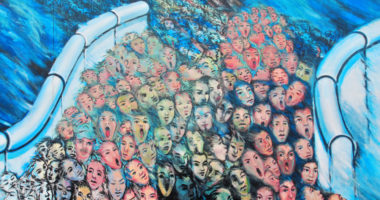Humanitarian aid workers frequently complain of ‘drowning in paperwork’ and working for agencies that are ‘bloated’ and ‘labyrinths’. They blame bureaucratic hurdles for impeding the delivery of aid during emergencies such as the conflict in South Sudan and the 2015 Pakistan earthquake.
And yet bureaucracy is fundamental to success for a humanitarian response. Stripped of negative ‘red-tape’ associations, bureaucracies are simply the systems and procedures that an organization uses to streamline complex operations. With clear hierarchies, division of labor, formal rules, and objectivity, bureaucracies are how organizations achieve their goals. For the humanitarian sector, this means responding to crises in a way that is fair, timely, and delivered equitably.
Three ongoing humanitarian failures offer illustrations for why humanitarian organizations may actually need more — and stronger — bureaucracy, not less.
Sexual violence and #aidtoo
Humanitarians, like so many other industries, are just beginning to reckon how prevalent sexual violence and misconduct is in the sector as cases become more widely discussed under the hashtag #aidtoo. From ‘sex-for-aid’ to unwanted sexual attention among aid staff, these cases occurred because policies, reporting strategies, and other official channels for preventing such crimes were too weak, allowing leaders to turn a blind eye (or even condone) such behavior. In some organizations the problems are so far-reaching that staff engaged in elaborate coverups. (Oxfam, Save the Children, and Mercy Corps are some of the most prominent examples, but they certainly are not the only ones.)
The #aidtoo problems stem from an inability to maintain and enforce existing rules, so it is stronger humanitarian bureaucracies that are needed to reduce these acts of sexual harm. Indeed, aid leaders told global development media platform Devex that to reduce sexual violence in the sector, organizations must strengthen bureaucratic practices, including: improving reporting on sexual harassment; strengthening internal sexual misconduct response mechanisms; and improving confidentiality and privacy policies.
Corruption and fraud
Corruption — by definition a subversion of formal systems — is a quintessential example of the problems with weak bureaucracy. While estimates of how much development or humanitarian aid is lost to corruption vary widely, most agree it is essential that all aid reach its intended beneficiaries. Profiteering, directing aid toward certain populations for personal gain, and siphoning off funds are all forms of corruption that have been documented in the sector.
Combating corruption is difficult, but humanitarian organizations can take concrete steps such as: implementing or strengthening whistleblower policies; requiring additional training of employees; conducting corruption risk assessments; utilizing an ethics office or similar entity; investing in monitoring and evaluation (M&E); improving auditing policies and practices; modifying human resource and financial policies; and more.
Humanitarian assistance can be particularly susceptible to corruption due to the weak states in which the humanitarian organizations tend to operate and the common need of a swift response. In this context, tailored solutions can help reduce corruption. As Paul Harvey of Humanitarian Outcomes notes, combating corruption requires bureaucratic controls that are as flexible and far-reaching as the humanitarian crises are diverse.
Politicized allocation of resources
How aid is allocated is decidedly non-bureaucratic, often driven by media attention, foreign government interest, and popular support. Aid organizations continually argue for more equitable allocation. The Norwegian Refugee Council, for instance, publishes an annual list of ‘the world’s most neglected displacement crises’. CARE puts out an annual Suffering in Silence report on ‘the most under-reported humanitarian crises’ of the year.
The inequitable allocation of resources is the result of a combination of ‘intentional choices’, explicitly prioritizing one group over another, and ‘unintentional action’ of not considering where to allocate aid. Stronger bureaucratic systems could provide formal metrics for where to allocate aid, moving away from politics and towards need. They could also shift the paradigm away from humanitarian aid toward more efficient modes of alleviating suffering like disaster risk reduction, which is often more cost effective than simply responding to disasters.
Within aid organizations, efforts to standardize, professionalize, and become ever more bureaucratic can threaten the agility necessary for rapid response to a crisis. But many severe problems stem from an underdeveloped rather than overdeveloped humanitarian bureaucracy.
That said, the context of humanitarian action is not always suited to a refined bureaucracy. Humanitarian action occurs in response to ambiguous, complex, and rapidly changing disasters, where formal systems have often broken down. At times rules are bent or even broken in the name of getting things done.
More importantly, bureaucratic and humanitarian impulses can conflict. Bureaucracy is about depersonalized processes and formal systems. While this can result in aid that save lives, alleviate suffering, and protect the dignity of populations in need, its rote procedures can seem to undermine the compassion that underlies humanitarian action. A bureaucracy that works for humanitarian action will be both strong enough to protect those who need it, but also flexible in the right situations to encourage human interaction and compassion.
See also
- Hugo Slim, Reflections of a humanitarian bureaucrat, January 9, 2020
- Hugo Slim, Trust me – I’m a Humanitarian, October 24, 2019







It is important to clearly understand the difference between bureaucracy and efficient and effective management. Three dictionary definitions all emphasise the negative effects of effective management becoming a bureaucracy.
• “Excessively complicated administrative procedure.” (Oxford dictionary)
• “a system for controlling or managing a country, company, or organization that is operated by a large number of officials employed to follow rules carefully” (Cambridge dictionary)
• “a system of administration marked by officialism, red tape, and proliferation” (Miriam-Webster dictionary.)
I doubt anyone would argue against the need for the most effective and efficient management of humanitarian operations. The problem is that it is far easier to create expanding self perpetuating bureaucracies than effective management. Effective management depends on having staff at all managerial levels who have an effective moral compass and who are enabled and supported in maintaining the highest ethical standards throughout humanitarian operations. Until humanitarian organisations achieve this no amount of bureaucracy will bring about the necessary changes. Quality of staff is more important than quantity of systems.